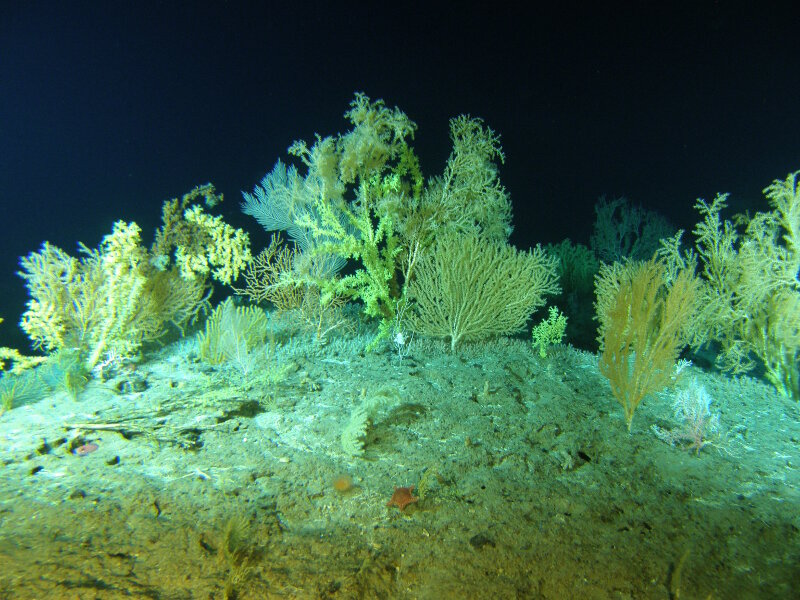
By Meagan Putts - University of Hawaii at Manoa

A high-density coral community from Pioneer Bank in Papahānaumokuākea Marine National Monument. We expect to observe similar communities in the Musicians Seamounts. Image courtesy of Hawaii Undersea Research Laboratory. Download larger version (jpg, 1.7 MB).
Since the early days of ocean exploration, scientists have been fascinated with understanding the pattern of species distribution throughout the marine environment. This area of scientific study is known as marine biogeography. Marine biogeographers examine the historical, geological, ecological, and environmental factors that influence the distribution of life in the ocean. This research helps to explain why species are found where they are and how populations are connected and spread from one location to another.
The deep sea is the largest habitat on the planet; yet, it is comparatively less explored in comparison to the surface of the moon. Advancements in remotely operated vehicle (ROV) design and seafloor mapping technology have allowed for greater exploration and characterization of this remote environment. With each new survey, there is a high probability that a new species will be observed and a range extension documented for a previously described species. This data collection helps to characterize and identify key habitats for deep-sea ecosystems. Key habitats might include high relief features with accelerated currents, such as ridges, pinnacles, and steep slopes, which are often associated with dense coral and sponge communities.

A representation of potential physical (current and depth) and biological (reproduction, larval behavior, settlement) forces that may influence dispersal, colonization, and genetic connectivity among deep-sea coral populations. Image courtesy of Shank 2010, Oceanography; Morrison et al. 2015). Download larger version (jpg, 302 KB).
Exploring these key habitats with the ROV Deep Discoverer provides us with a better understanding of the relationship between the environment and the organisms that live there. This, in turn, will allow us to better predict where species might aggregate and dense communities might be found. However, we have barely scratched the surface of understanding how populations are connected.
So, how do species come to colonize different locations on the seafloor? The short answer is dispersal, or the transport of an individual or group to a new habitat that meets that species’ requirements. For benthic, bottom-dwelling species, which include corals, sponges, and certain fishes and invertebrates, new populations are founded by the dispersal of larvae.

A high-density coral community from Pioneer Bank in Papahānaumokuākea Marine National Monument. Image courtesy of the Hawaii Undersea Research Laboratory. Download larger version (jpg, 1.5 MB).
Since larvae are plankton and are not strong swimmers, species dispersal to isolated locations is generally driven by ocean currents and the availability of suitable habitat. As a result, we see the formation of genetically connected but spatially separated populations. These populations play an important role in species resilience by bolstering the geographic range and genetic diversity within a community.
Like islands, seamounts are often hotspots of biodiversity and can serve to connect or isolate populations because they are shallower habitats in the vast abyssal plain. In addition, the physical structure of seamounts can accelerate currents and create eddies that can scour sediment from the seafloor, concentrate larvae and other plankton, and enhance food supply to the benthic environment.
Communities on seamounts and nearby slope habitats are often populated from a regional species pool, meaning that habitat at similar depths are connected and tend to support a similar diversity of organisms that are genetically related. This is known as seamount connectivity. Identifying the connectivity of seamount populations and quantifying their diverse ecosystems is essential to developing plans to conserve and manage seamount resources such as precious coral and deep-sea fisheries as well as minerals like manganese crusts. One way to preserve the structure and function of unique and representative ecosystems is to establish networks of marine protected areas and marine monuments in strategic locations.

High-density coral community from Keahole Point on the Island of Hawaii in the Main Hawaiian Islands. Image courtesy of the Hawaii Undersea Research Laboratory. Download larger version (jpg, 4.5 MB).
As one of the closest seamount groups to the Hawaiian Islands, the Musicians Seamounts may serve as a source of genetic diversity and be a point of connectivity to the Papahānaumokuākea Marine National Monument and Main Hawaiian Islands. As we explore the little-known Musicians Seamount chain, we expect to see a variety of new species and many familiar species known from the Hawaiian Islands.
The species assemblages we will observe have the potential to fill in important gaps in our knowledge of the biogeography and connectivity of deep-sea coral and sponge communities in the Pacific. Furthermore, this expedition could stimulate additional research and discovery in this mostly unexplored frontier.
Clark, M. R., Rowden, A. A., Schlacher, T., Williams, A., Consalvey, M., Stocks, K. I., ... & Hall-Spencer, J. M. (2010). The ecology of seamounts: structure, function, and human impacts. Annual Review of Marine Science, 2, 253-278.
Morrison CL, Baco AR, Nizinski MS, Coykendall DK, Demopoulos AWJ, Cho W, Shank T (2015) Population Connectivity of Deep-Sea Corals. In: Hourigan TF, Etnoyer PJ, Cairns SD (eds) The State of Deep-Sea Coral and Sponge Ecosystems of the United States: 2015. NOAA Technical Memorandum X. NOAA, Silver Spring, p 12-1 – 12-30.
Watling, L., Guinotte, J., Clark, M. R., & Smith, C. R. (2013). A proposed biogeography of the deep ocean floor. Progress in Oceanography, 111, 91-112.